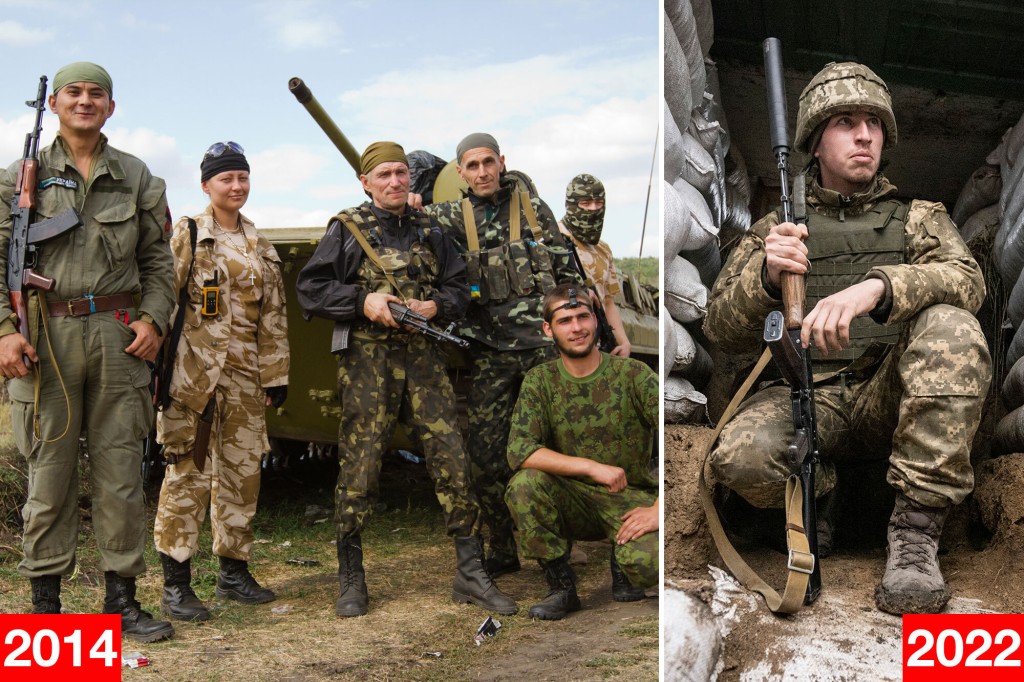KIEV — It’s a scary time here in Ukraine. That’s saying something, because the past eight years haven’t been easy.
While covering this war since 2014, I’ve seen combat of an intensity greater than anything I experienced as a US Air Force special-operations pilot in Iraq and Afghanistan — as well as what I witnessed as a journalist in both those wars.
Heavy artillery, rocket attacks, trench warfare, a civilian airliner shot from the sky. In September 2014, I witnessed tank combat outside the coastal city of Mariupol.
Today, Ukrainian troops remain in daily combat against a combined force of Russian regulars and local conscripts drawn from the Russian-occupied territories in eastern Ukraine’s Donbas region.
An uneasy stalemate has lasted for years. Yet with two of Europe’s largest land armies trading fire every day in the Donbas, there has always been the chance that this limited trench war could escalate into a far bigger and deadlier disaster. Today, we are on the verge of that nightmare scenario.

The news that Russian troops entered Belarus on Jan. 17 is a chilling indication of the possible size and scope of an offensive that may be only a few weeks away. A Russian offensive to encircle Ukraine’s capital city of Kiev now looks like a realistic possibility.
We are in the midst of Europe’s most dangerous moment in decades. Bomb-shelter signs are again going up in Kiev. Civilians are banding together to defend their hometowns. Ukrainian families are grappling with tough choices they soon may have to make, such as whether to flee their homes in the dead of winter or stay put and ride out a possible Russian siege.
One line of thinking is that Russian forces would execute a swift, overwhelming strike meant to inflict massive and irrecoverable losses on the Ukrainian military that would spur a political capitulation (and possibly a change in government) in Kiev.
In the worst scenario, some 100 Russian battalion tactical groups would invade Ukraine from multiple vectors, likely preceded by waves of airstrikes and rocket attacks. In response to that threat, Ukraine has increased air defenses at key locations across the country. And in Kiev, officials are reviewing evacuation plans and preparing bomb shelters.
Most Ukrainians were skeptical at first about the likelihood of a full-scale Russian invasion this winter. But the mood has shifted, and many now believe that a wider war is truly possible.

At least one-third of Ukrainians, according to recent polling, are ready to take up arms and resist a Russian invasion by force. And this isn’t bluster. After almost eight years of conflict, Ukrainians harbor no naive or romantic impressions about what war is.
When Russia invaded the Donbas in 2014, Ukraine’s regular armed forces could muster only a few thousand combat-ready soldiers. With the country facing an existential threat, Ukrainian civil society launched a grassroots war effort, forming a coalition of civilian volunteer battalions. These units are made up of men and women, young and old, often with little or no military experience, including both native Russian and Ukrainian speakers from all regions of the country. Many of these volunteers learned how to be soldiers while in combat — a baptism by fire they refer to as “natural selection” boot camp.
This grassroots effort reversed Russia’s unconventional invasion of the Donbas and fought the war to a stalemate, which persists to this day. Now, amid the threat of a bigger war, we see again that spirit of resistance from Ukrainian society.


This time, however, a nationwide resistance movement, while inspiring, may not be effective against a conventional Russian blitz comprising air power and massive amounts of armor. That said, Ukraine’s regular armed forces are no pushover. Their transformation over the past eight years has been remarkable.
The Ukrainian army is a professional, disciplined and battle-hardened force. The military is ridding itself of the Soviet chain-of-command model, in which decision-making was concentrated at the top, leaving frontline troops with little flexibility to exercise initiative while under fire. Ukraine’s frontline officers now have the autonomy to make their own decisions in combat. These changes have made Ukrainian units more adaptable to battlefield realities and less reliant on centralized orders from headquarters — useful attributes for operating in a fog of war generated by Russian cyberattacks and air power.
Western military aid has improved the survivability of Ukraine’s combat forces in the Donbas. And deliveries of such weapons as US Javelin antitank missiles, as well as the Jan. 17 British airlift of antiarmor weapons to Kiev, all go a long way toward boosting morale within the Ukrainians’ ranks.
Apart from the symbolic value, however, I fear it’s already too late for Western military aid to improve Ukraine’s ability to defend against a major Russian offensive. The North Atlantic Treaty Organization and the European Union should also consider preemptive deliveries of humanitarian aid to prepare for the possibility of millions of displaced people in the dead of winter.
Ukrainians have the will to fight. Western support, whether through diplomatic gestures or weapons, signals to Ukraine’s soldiers and civilians that they haven’t been forgotten and that their dream of democracy and freedom is worth fighting for. That’s a message the world needs to hear.

During World War II, a single human lifetime ago, Ukraine was one of the deadliest battlefields of the deadliest war in human history. No one should think that another war like that is impossible, or that the events of our time are somehow immune to history’s endless cycles of war and peace.
In “For Whom the Bell Tolls,” Ernest Hemingway wrote: “If we win here, we will win everywhere.”
I can’t think of a better way to explain why Ukraine’s fate matters to NATO, the US, and democracies around the world.
Nolan Peterson was a captain in the US Air Force and is author of “Why Soldiers Miss War.” From The Wall Street Journal.





